
Data Systems Research and Development
Oak Ridge Federal Facilities [external]
| Project Metadata | Keywords | ||||||||||||||||||||||||||||||||||||||||||||||||||||
|
|
Geo-political decisions can be critical determinants of success in war and peace. These decisions are based on predicted psychological and sociological responses by the various individuals and groups in the decision environment. For example, mental models are used in deciding whether to display our naval "presence" in a foreign port or whether a discussion on the golf course would be more effective. However, in constructing consistent policies over long periods of time that involve the conflicting interests of many countries, the complexities often overwhelm mental models. In evaluating proposed actions, questions should address the immediate impact of an action, the long term impact, the potential for diverse impacts throughout the populations of interest, and the consequences of previous actions by other parties in the decision environment. A computer implementation that combines and extends the mental models might be useful; however, designing such an implementation is a hard problem. This paper presents a philosophical framework for modeling psycho-social attributes at the theater level and develops some of the necessary structure for a model.
A "psycho-social attribute" is a fancy label for such hard to model things as fear, suppression (of various activities), addiction, sympathy, ownership, and democratic leanings. These are human attributes that are significant activity drivers in lower intensity conflicts (LIC) and operations other than war (OOTW). Figure 1 illustrates the fact that many of the transitions from one world-state to another are mediated by psycho-social factors. (Exceptions include natural disasters; however, subsequent state changes caused by human reactions to disasters most definitely do involve psycho-social factors.)
Figure 1. Centrality of Psycho-Social Factors

The psycho-social factors that influence conflict have been avoided in many explicit modeling domains. For example, political-military questions have most often been addressed through seminar wargames, in which these human factors are coped with by humans who react, and thus embody the model. These wargames provide insight into possible extrapolations of situations; however, they have low predictive power, limited generality, and little carry-forward to other wargames. On the other hand, fatigue and fear in combat are generally ignored in computerized combat models, which are designed for predictions (within limits), generality, and to embody corporate memory. In these models, the questions being answered are restricted to those in which the psycho-social effects may be presumed to be constant over the domain of interest. (This has been true, in part, due to a reluctance to defend conjectural models.)
The end of the Cold War has been accompanied by a shift in the nature of the questions needing answers. High intensity combat no longer dominates the scenario environment. In low intensity combat and non-combat conflict scenarios, the psycho-social factors have a greater importance than they hold in high intensity combat scenarios. Figure 2 illustrates the point that not all effects are generated by the rational, engineering style effects of an action, that psychological and sociological effects are valid components in generating the resultant vector. As Figure 3 shows, the effects can depend on the intensity of the conflict and the functional form of this dependence can vary over the nations of interest.
Figure 2. Components of Effects
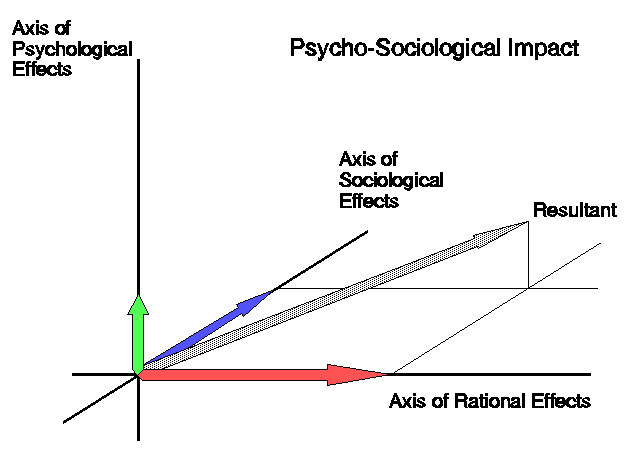
Figure 3. Variablity of Psycho-Social Effects
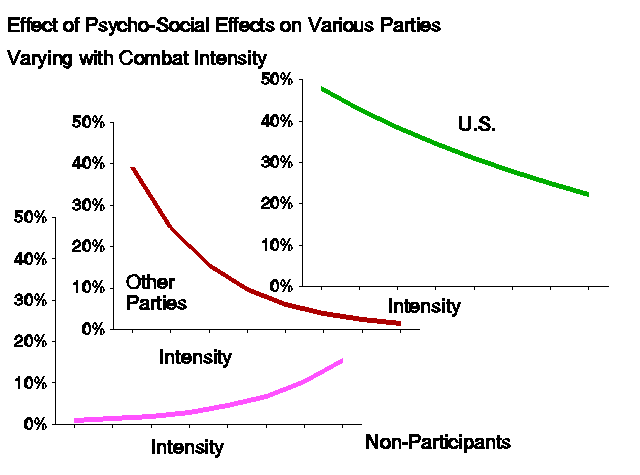
What are the effects of gunboat diplomacy? What are the effects of conventional diplomatic approaches? What are the effects of economic ties? What are the effects on each of the parties involved and observing the actions? The modeling framework described in this article does not answer these questions. It does, however, provide a method of writing down any postulated answers in a way that allows them to be linked to other postulated answers and to be manipulated. Further, by insisting on a specifics, the postulates are opened to debate and improvement.
These newly important scenarios are also different in immediacy. The old Cold War scenarios were virtually constant, allowing six- month to two-year studies of a particular question. The new scenarios are, by comparison ephemeral. Answers may be needed in days or hours, not months. Models that produce stacks of paper to be digested into reports and briefings are no longer satisfactory. Graphical and directly understandable output is required. The computer hardware and software of the 1970's could not have supported these requirements. However, today's hardware and software are capable of meeting the challenge.
Given a need and the physical tools to solve the need, the question becomes one of ability to model psycho-social interactions well enough to provide the logical tools. Despite any understanding of these interactions in a laboratory setting, it is not clear how to scale what is known or thought about these factors to conflict at the theater level. (For purposes of this article, a theater can be thought of as a country or a group of countries.) This article presents a philosophical framework for modeling psycho-social attributes at the theater level. The framework uses broad approximations of the interactions of these and other factors that allow easy substitution of theories, if and when the accepted theories are changed.
The concept derives from the problem of attrition and detection of small units in a sparsely populated theater. In the cold war European scenario, units were so densely packed that major attriting systems (such as brigades and large surface- to-air missile (SAM) batteries) covered every route through enemy territory. "Enemy territory" was a concept that was very easily defined.
However, in many likely current scenarios, major attriting systems will be sparse. A map of the theater would show local concentrations and large areas of unoccupied territory. Ownership of terrain will not be apparent. Certain routes will appear to be safe, because no enemy unit occupies it. Figure 4 illustrates the situation. (A square grid is used for simplicity; however, the same effect occurs on a hexagonal grid, on a network and on an (x, y)-terrain with range circles.)
Figure 4. Ownership of Territory by Occupation
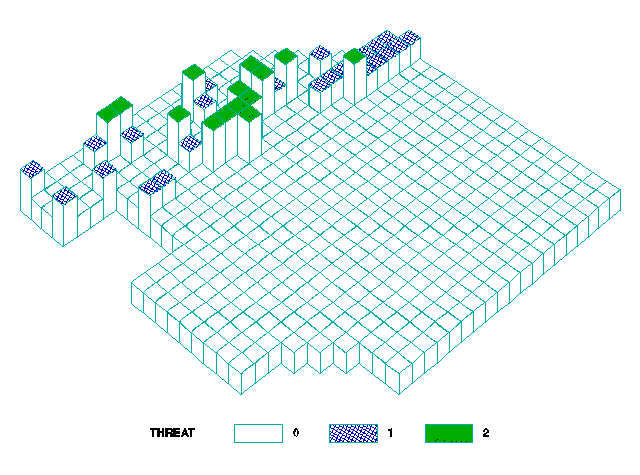
These safe routes will be, in part, illusory, an artifact of the level of detail. In many cases, units too small to represent practically will be dispersed over the terrain. While these units may be too small to deal significant damage to a combat-ready brigade on the assault, they may have the weapons to shoot down some fixed wing and rotary wing aircraft and destroy some armored and unarmored vehicles. Similarly, the populace may be more fervently for the military when it is present than when it is not and the further in space and time, the less fervent. These effects should be represented in some fashion in the model, because they will affect the prosecution of a real conflict.
The analyst knows what territory is "enemy" territory, but the model doesn't. Further, a model that contains a detection module cannot detect any threats in the empty grid squares, because none exist. For simulations that explicitly model uncertainty this presents a problem for modeling false detections. Figure 5 shows a space decay function. The darkest ellipse indicates a 100% value, degrading to 0% external to the largest ellipse. This function extends point values over a 2-dimensional region. Its twisting, elliptical form is chosen to emphasize that a circular normal decay function is not the only possibility. Figure 6 shows a time decay function, in this case an exponential function (line) fit to some sample data (bars).
Figure 5. Representing Diminishing Influence with Distance
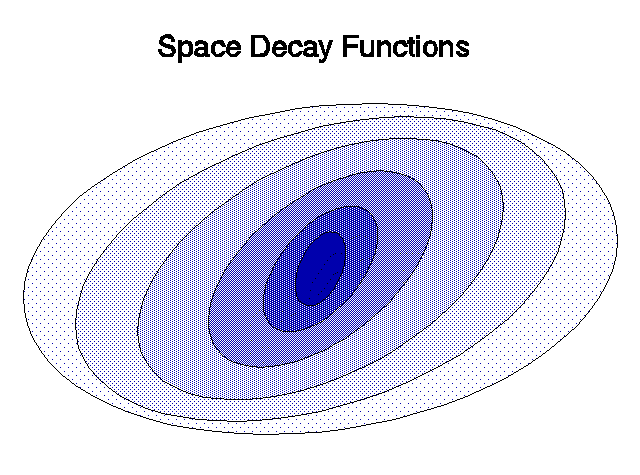
Figure 6. Representing Diminishing Influence over Time
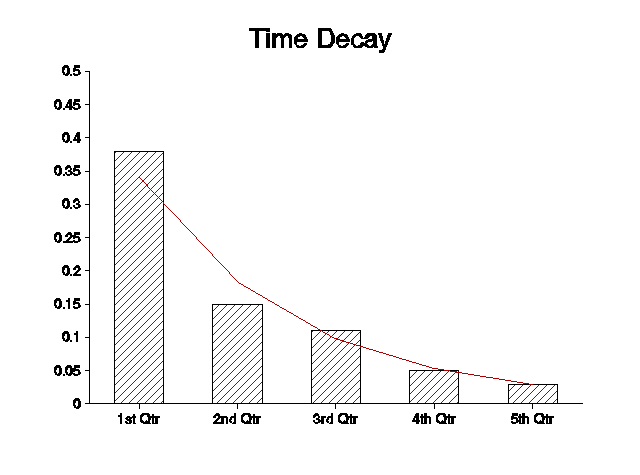
Figure 7 illustrates the application of time and geographic decay rules to a basic "occupancy as ownership" rule. The scalar field of Figure 7 represents enemy-sympathy. In a strict two-sided conflict, it might be desirable to maintain a single scalar field, denoting a spectrum between friendly-sympathy to enemy-sympathy. However, in a multi-sided conflict (and perhaps in a two-sided conflict as well), multiple scalar or vector fields are needed, one dimension for each side. In these cases, the value of the fields might represent the percent of the populace maintaining the particular sympathy, rather than the fervor of the sympathy. The rules for geographical and time decay are debatable and should be chosen after due consideration of the situation being modeled. Once a method of determining territorial ownership has been determined, the likelihood of finding small units (below the basic model resolution size) in any given location can be determined. In Figure 8, the danger in a given grid square is based directly on the ownership determination and has been converted from a continuum to a set of discrete values. Lower-threat corridors still exist and no-threat corridors are possible; however, the threat levels are more likely to model reality than in the previous case. Naturally, the rules for different threat types can be heterogenous and can depend on more than ownership rules.
Figure 7. Smooth Representation of Extended Ownership of Territory
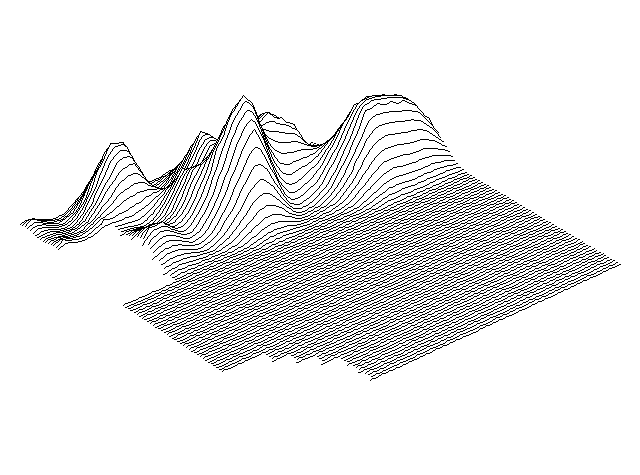
Figure 8. Digitized Extended Territorial Ownership

This methodology permits attrition (with some appropriate probability) over wider areas than merely those covered by the weapons associated with those units large enough to be explicitly represented. It also permits detection of enemy units (and possible misinterpretation of those detections) in grid squares other than those occupied by the explicitly represented units. The creation of a meaningful definition of territorial ownership beyond occupation by explicit units also permits modeling objectives beyond attrition of the enemy.
The ownership concept introduced here is merely a rough approximation. The distance in time and space of combatants is the only factor used in the definition. However, more complex definitions and interactions are possible once the principle is accepted. Sympathy can be expanded to economic and political dimensions. Specific activities of the combatant forces can have differential influences. Non-combatant forces can be defined with activities that have measurable impacts. The psycho-social factors can have impacts on the combat beyond the implied access of one side or another's small units to the territory. Movement rates and combatant morale can be affected. Refugee flow rates can be modeled. This principle opens the door to modeling many important factors beyond high intensity warfare.
A key concept is dual level of resolution, illustrated in Table 1. The most important objects in the model are specifically enumerated, e.g., the heads of state and the key governmental and non-governmental organizations for each country. The rules for evaluating the impact of each potential factor (and the interactions) are developed specifically for each object, based on their known characteristics. These objects represent the basic level of resolution for the model.
Table 1. Psycho-Social Objects
| SIGNIFICANT (NAMED) INDIVIDUALS 5 - 6 per Country |
| PARTICULARIZED GROUPS Ruling class Military elite Civil servants Moneyed class |
| DEMOGRAPHIC CATEGORY, BY GEOGRAPHIC
LOCATION Ethnic, Religious, Economic |
| GEOGRAPHIC LOCATION Proximity |
The second level of resolution of the model is concerned with the diffuse psycho-social attributes of the populaces (or sub-cultures) of the countries. Geographical and time related effects will be important, as well as innate characteristics. This level of resolution is important because some overtures are aimed at the populace and will show no effect unless there is a populace to be affected. The principal actors react not only to direct approaches, but also to responses by the populace to various factors.
Table 2 lists several potentially important factors or attributes. Scalar field factors of interest might include support for democracy, support for autocracy, criminal activity, fear, capitalist activity, sloth, addiction, spying, or terrorism. Which are important and how they are interrelated will be difficult questions to resolve; however, estimates can be made and corrected as the data indicate.
Table 2. Psycho-Social Attributes
| Fear Suppression (of various activities) Ownership, Work ethic Democratic leanings Economic competition, Espionage, Pirating Religious conflict Crime - general, Narcotics Drug costs Health levels Political corruption Spectrum of pro-country X sympathy Spectrum of fervor for causes, percentage favoring Spectrum of morale Refugee flow rates Terrorism level |
In many situations, the effects produced by the second level of resolution of the model should be distinctly second-order effects, and not very important. However, the dissolution of the Soviet Union very strongly involved more than just the actions of the original principals. Nation building operations will depend heavily on affecting the populace. It is not clear when this level of resolution can be omitted and prudence thus argues for its inclusion in OOTW scenarios.
The methodology of this article creates a notation for recording geo-political policies and their effects over time. One would first create a model of the region of interest and develop the first level of resolution objects, based upon best guesses of personalities and psychologies of the key individuals. Then the second level of resolution would be developed, based on general psychology and specific cultural influences. Past policies would be gamed in the system to test for first order effects. Questions of interest will include: What is the immediate impact of X? What is the long term impact of X? Where are the likely "hot spots?" The variable X could be actions such as treaties, golf with prime minister, or military exercises. The results should be assessed cumulatively, because everything counts.
Figure 9 provides a sketch of some of the concepts. the line of E's marching down the figure represents events that have potential impacts. Each event has time of occurrence and location information, as well as information about its nature. In this figure, Event 4 (E4) is the current event. The two heavy, solid lines originating at E4 indicate that it impacts both levels of resolution, enumerated objects and demographic categories. The specifically enumerated objects are represented in the figure by three people (P1, P2 and P3, in circles) and three particularized groups (G1, G2 and G3, in ellipses). The diffuse populaces are represented by three demographic categories (C1, C2 and C3, each with a territorial coverage representation, including population density).
Figure 9. Concepts of Psycho-Social Interactions
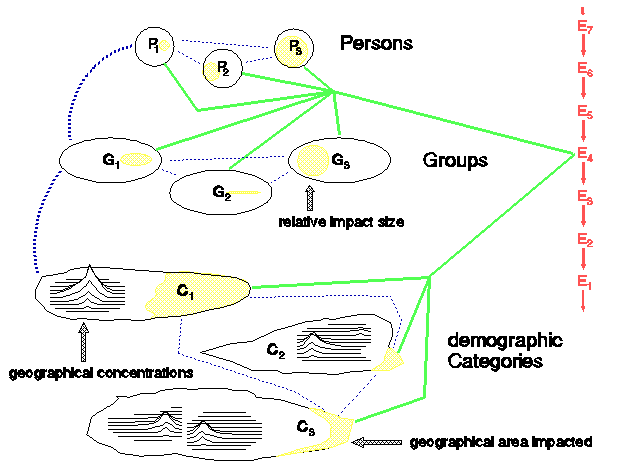
The demographic categories are indicated as occupying distinct geographical areas (the overlap must be imagined in this figure), with population density variations within the areas (indicated by the three-dimensional sketches). The impact of E4 varies in size (shaded regions) in the enumerated objects and in geographical effect in the demographic categories. For simplicity, the variation in impact on different psycho-social factors is omitted in this figure. Interactions among objects are indicated with dotted lines. These interactions propagate over time and include reactions to past events.
The interactions among the objects, events and attributes comprise the content of the model. In general, the interactions among the attributes can be divided into two elements: the connections, that is the definition of which attributes influence which other attributes, and the algebraic formulae for the connections. Figure 10 illustrates an influence diagram connecting several psycho-social attributes and events. Note that the particular attributes of this example are denoted only by category, illustrating the concept not expressing the solution. Influence diagrams are useful in eliciting knowledge and in conveying their content because of their formalism is easy to learn and does not obscure the content.
Figure 10. Notional Influence Diagram of Psycho-Social Factors and Outcomes

Some problems may have special features that permit the use of well defined engineering models. Some aspects of the drug war may fall in this category. Consider a network topology for the world, centered on the United States. One might construct nodes to include sources of drug precursor chemicals and agricultural production, centers for conversion, transhipment nodes, distribution nodes, and demand nodes. The links would consist of the distinct transportation modes and routes. The supply and demand node concepts certainly resemble electrical sources and sinks. The carrying capacities of the links and the interdiction (resistance) efforts have analogues in the world of electrical engineering (see Figure 11 for a sample circuit diagram). The solutions to the electrical equations produce rules that can be used to define a scalar field over the network. Adjunct scalar fields might include addiction levels, drug costs, crime levels (in support of drug habits), and various societal costs. The elaboration of rules concerning the effectiveness of interdiction efforts, demand reduction efforts, and losses en route, together with this model, might yield a tool that permits the study of the problem and proposed activities.
Figure 11. Using Circuit Diagrams as Models
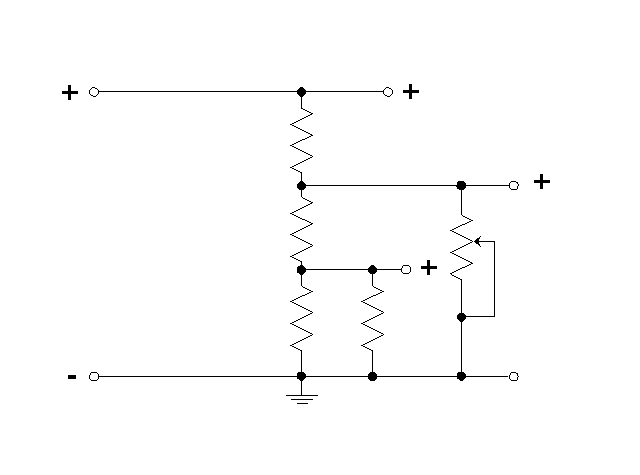
In more general situations, potentially useful techniques for generating the algebraic formulae include the differential equations of ecological predator-prey relationships and the ecologic concept of carrying capacity (both of physical quantities such as numbers of refugees, but also for psycho-social attributes such as turmoil, diversity, and dissension.) Other important concepts are embodied in macro-economic equations and Lanchestrian attrition equations. Equation (1) illustrates the concept, using a difference equation approximation approach with the quantities defined in Figure 9. The outcome, MOE, is defined to be the level of amity toward the U.S. For each time step, the change in a given person's amity level, Pi, is defined to be a function of the event in question, less the decay in Pi due to time, plus the weighted sum of the old values for the other persons, the groups, and the demographic categories (integrated over their areas), plus a function of other factors. The new value of Pi is the sum of the old value and the change. Similar calculations are performed to obtain new values for each of the other persons, the groups, and the demographic categories. The MOE value is a weighted sum of the new values for the persons, groups, and demographic categories, subject to a test that no "hot spots" exist, that is areas A for which the integration over some demographic category has an integrated value less than or equal to a cutoff value -K. It should be emphasized that this formulation is illustrative only.
Equation (1)
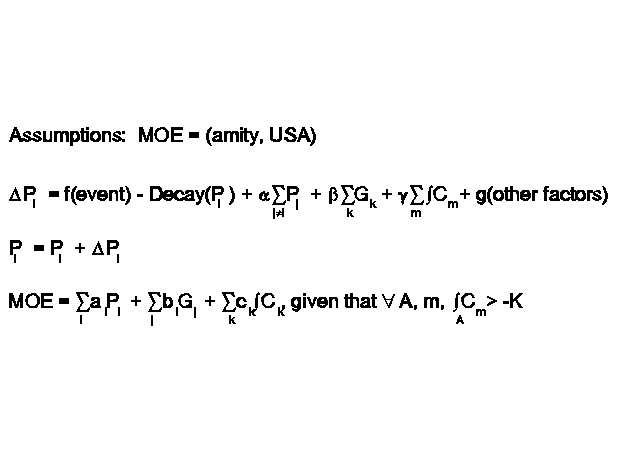
The purpose of this model is to permit the exploration of decisions and their possible results. One requirement is ease in visualizing results. A second requirement is that the functions that drive the results must be understandable and susceptible to modification. The model, as described, has the potential to be completely incomprehensible to its desired users and intractable as concerns updating the driving parameters. Such a result would make the model useless.
However, there are commercial games on the market that are based on similar, independently originated concepts. The popularity of Sim CityTM (Sim City is a registered trademark of MAXIS) attests to its usability and accessibility. Figure 12 shows a combination of land use indicators and an output variable (such as threat) density, combined. This presentation mode is used (for various demographic factors) in Sim City. In addition, Sim City includes graphs of various output variables, such as crime rate and total population as they change over time.
Figure 12. Using the Sim City Paradigm
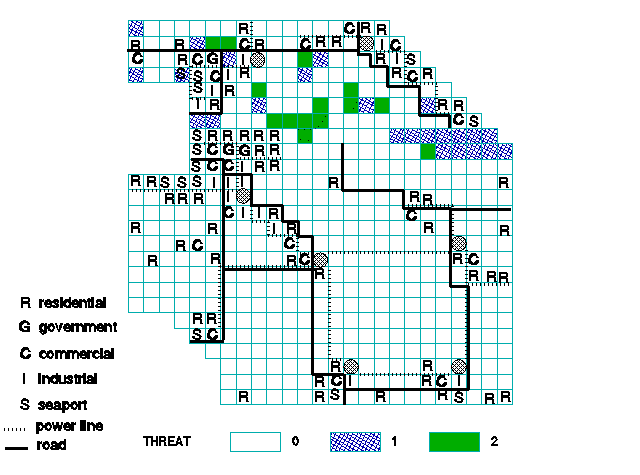
Sim City was designed as a game and as such has fixed rules that are inaccessible to the player. The simulation design for geo- political modeling would require accessible rules and a user interface designed for simple and accurate modification of the rules. The access would require two levels. The first level would permit parameter modification, while the second level would permit formula modification. These points are emphasized in the design decomposition shown in Figure 13, where the algorithms are classified as data within the model logic and the model shell is designed for display and modification of the data and logic. The formulation of the model as a time-based simulation would replace the need for recursive formulas with simpler approximations, using time steps to diffuse effects throughout the factor space.
Figure 13. Model Design Tasks

This model must be developed through use of the model. Differences in model predictions and observed data would be investigated. Close initial correspondence would not be expected for two reasons: the object/attribute/event interactions in the initial model would be very rough and the observations of reality would be based on undirected data gathering. This is a "ready, fire, aim" approach as opposed to a "ready, aim, fire" approach, as illustrated in Figure 14. The variation is used because aiming presupposes more understanding of the real-world connections among factors than actually exists. "Ready" corresponds to building the model. "Fire" corresponds to using the model to make predictions. "Aim" corresponds to testing the predictions against observed reactions.
Figure 14. Model Design Philosophy
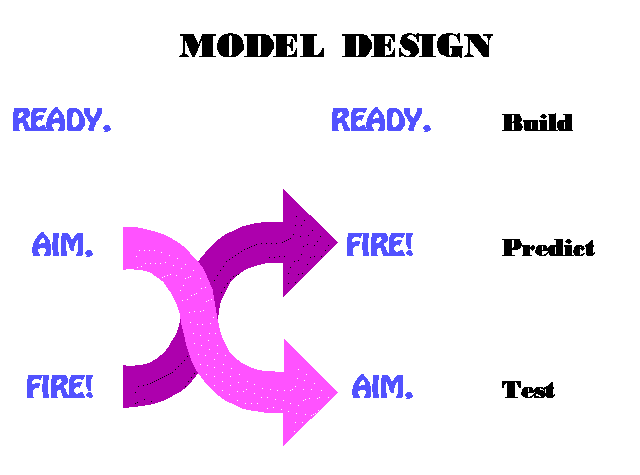
Use of the model over time would begin with seminar games in which the principal benefit to the participants is structured discussions. However, whatever actions are actually taken (in the real world) would be input to the model and its predictions checked and corrected. As the model results become more trustworthy, the geographic and time display of selected factors will become useful analysis aids in understanding the state of the region. Once this tool becomes useful, intelligence collection aimed at testing and refining such displays may be instituted. The formulas would be refined using a Bayesian strategy, in which hypothetical parameter values are adjusted in the directions indicated by evidence as it is collected. The strategy for developing the model would consist of prototyping with incremental improvements (a version of the evolutionary spiral process, as shown in Figure 15).
Figure 15. Evolutionary Spiral Design Process
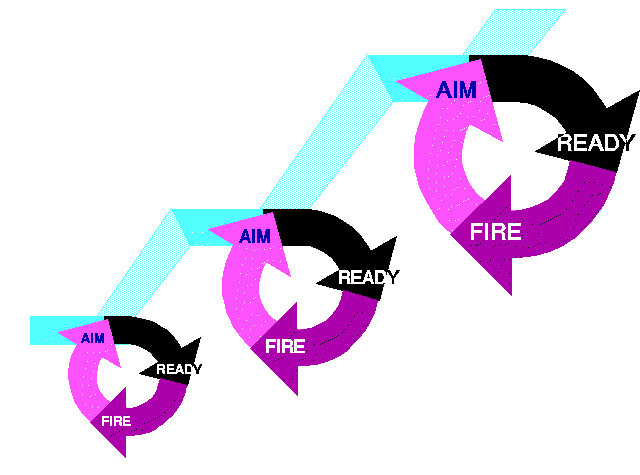
High intensity combat is driven by attrition (killing, wounding or capturing people and destroying or suppressing the use of equipment and facilities) and by maneuver (positioning forces to perform or threaten attrition). It is driven by attrition and maneuver because they are immediate and preemptive. Other concerns are held in abeyance. However, absent the overriding concerns generated by high intensity combat, other concerns influence human activities. The influences are complex and the concerns are manifold. The art of shaping events to produce desired ends is nearly impossible to master and even achieving indifferent success is difficult. Despite this difficulty, governments are tasked to achieve results.
The philosophical framework for modeling psycho-social attributes at the theater level is driven by the questions to be asked and based on a dual level of resolution of the entities. (See Figure 16.) The first level is a moderately conventional one: the most important actors are modeled explicitly. The second level is required by the diffuse, but important, effect that the general populace has in these problems. Scalar and vector fields with geographic and time effects are used. The framework employs broad approximations of the interactions of the factors that allow easy substitution of theories, as they may become available. The experience of commercial games shows that it is possible to produce a useable model with good presentation methodology. The necessary update facilities would need to be added, however. The framework described here may provide the key to successful modeling of some difficult features of human conflict.
Figure 16. Hierarchy of Elements of Concern
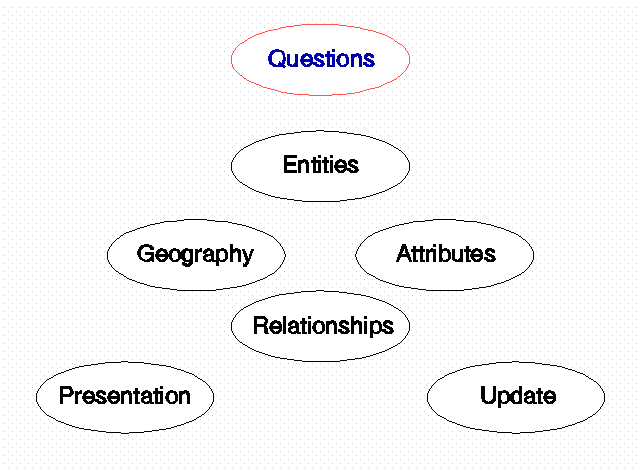
Two critical questions remain that have not been addressed in this article: Is the need for modeling psycho-social factors in conflict large enough to warrant funding attempts to perform such modeling? And does the will exist to use such models in the face of the unavoidable uncertainties and errors that will exist in such models? The first question is certainly a proper question for funding agencies - resources are not infinite and should be expended where most needed. The second question involves the balancing of the need for a solution through the use of the model and the need to know the solution is correct. The answer will depend on the situation.
The submitted manuscript has been authored by a contractor of the U.S. Government under contract No. DE-AC05-84OR21400. Accordingly, the U.S. Government retains a paid-up, nonexclusive, irrevocable, worldwide license to publish or reproduce the published form of this contribution, prepare derivative works, distribute copies to the public, and perform publicly and display publicly, or allow others to do so, for U.S. Government purposes. The Oak Ridge Federal Facilities include the Oak Ridge K-25 Site, the Oak Ridge Y-12 Plant, and the Oak Ridge National Laboratory, which are managed by Lockheed Martin Energy Systems, Inc., for the U.S. Department of Energy.
This work was also published as a chapter in a book.
If you arrived here using a keyword shortcut, you may use your browser's "back" key to return to the keyword distribution page.
Return to Hartley's Projects Page